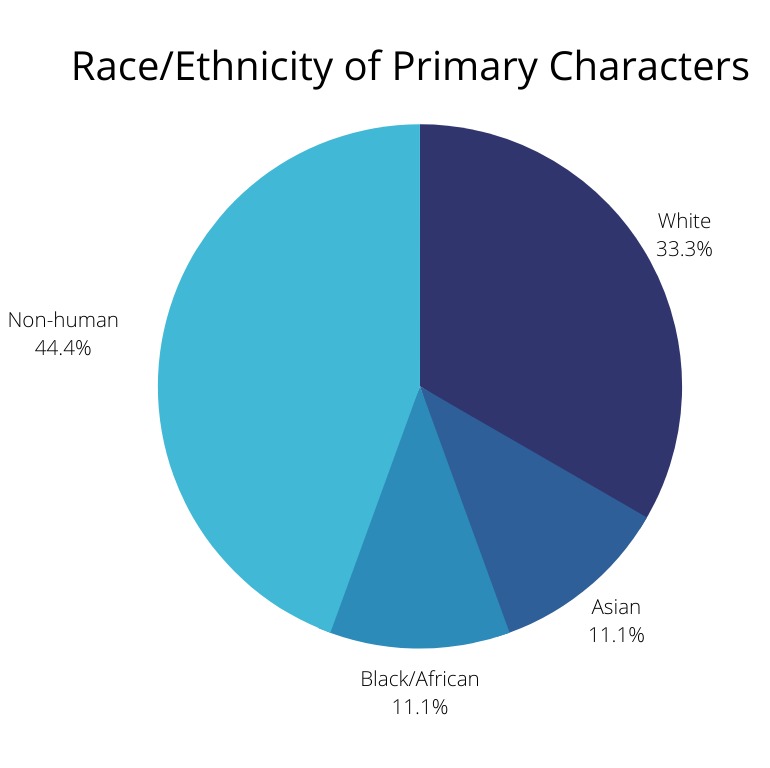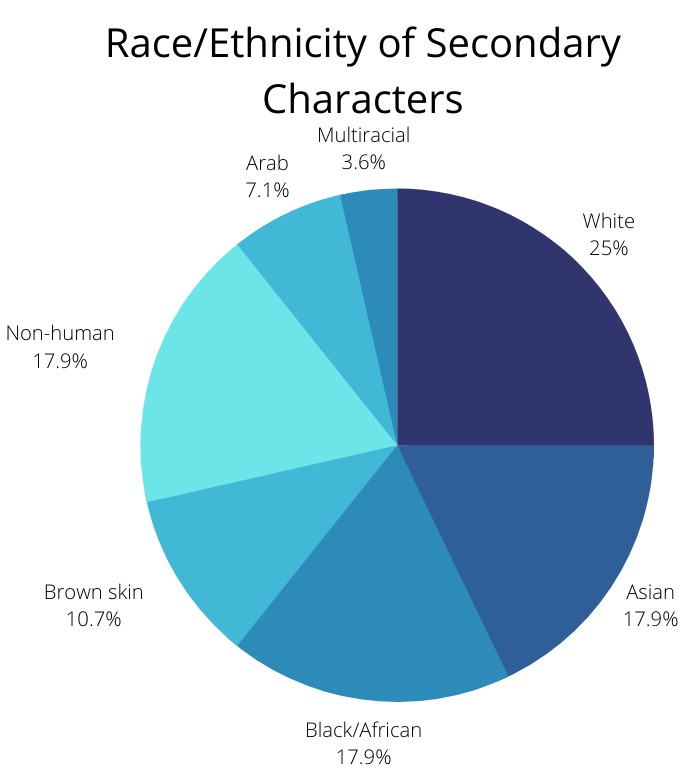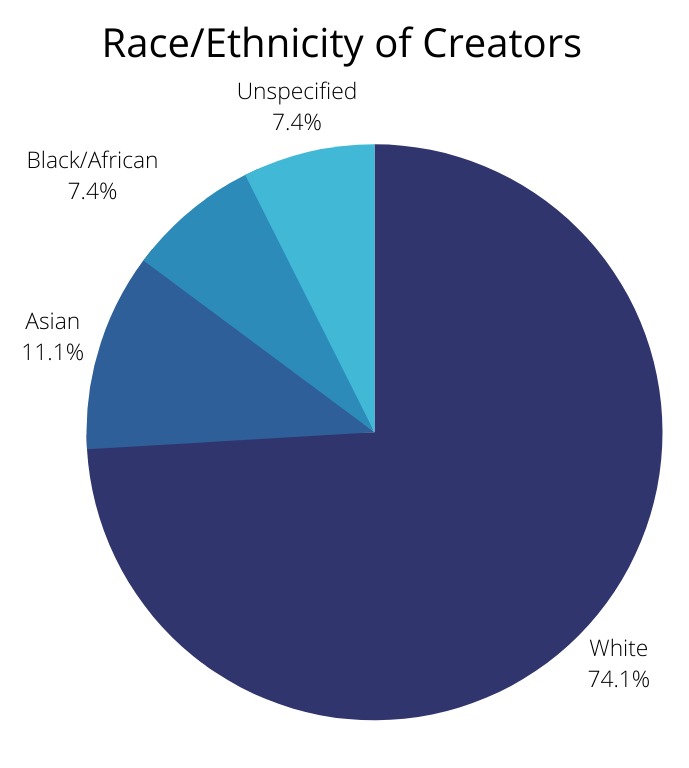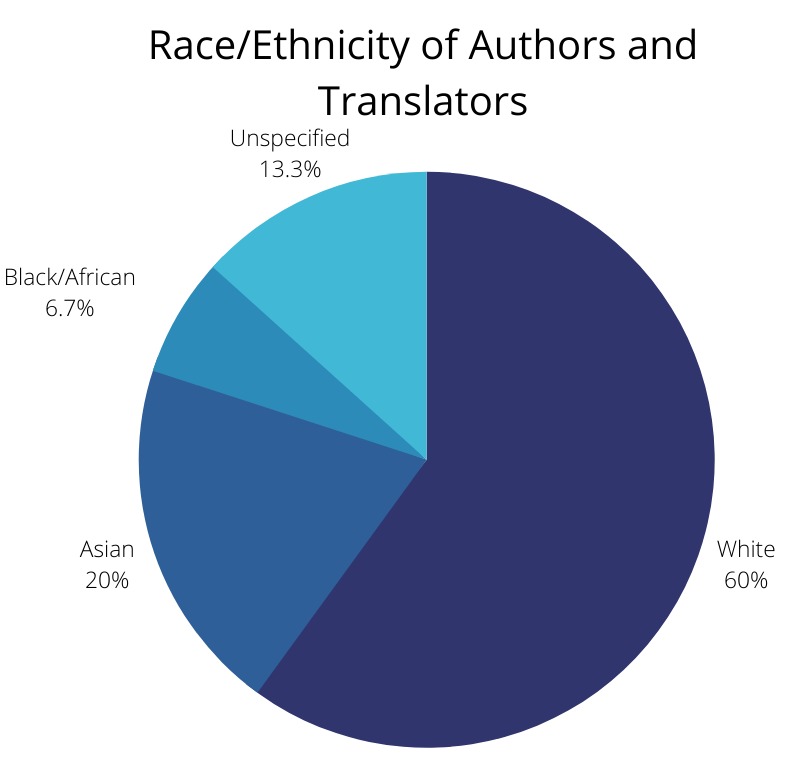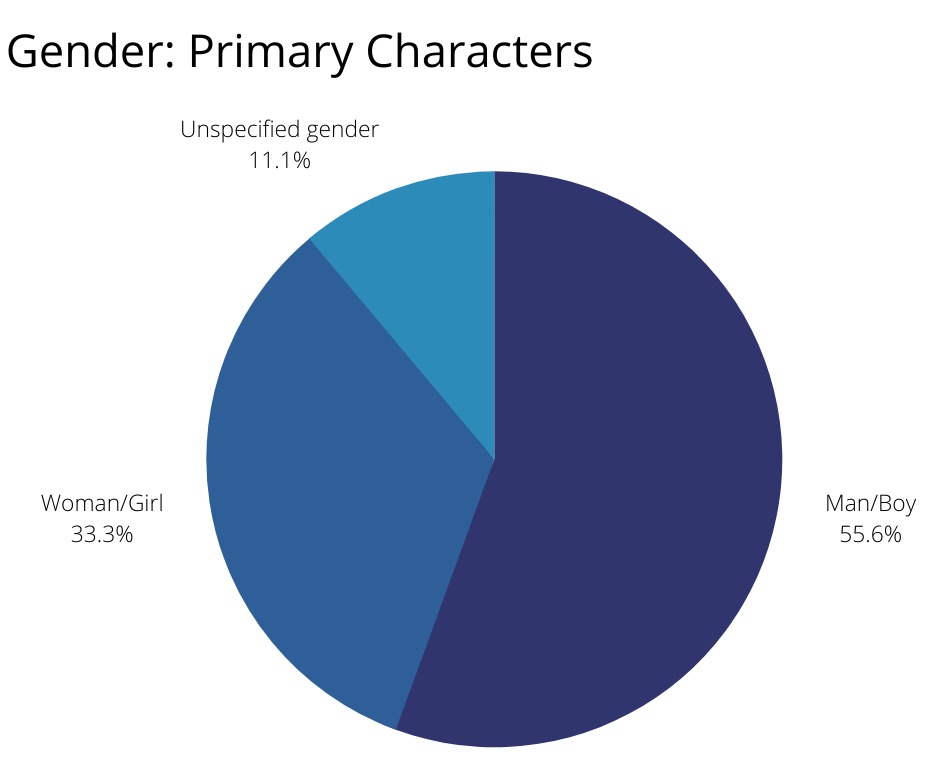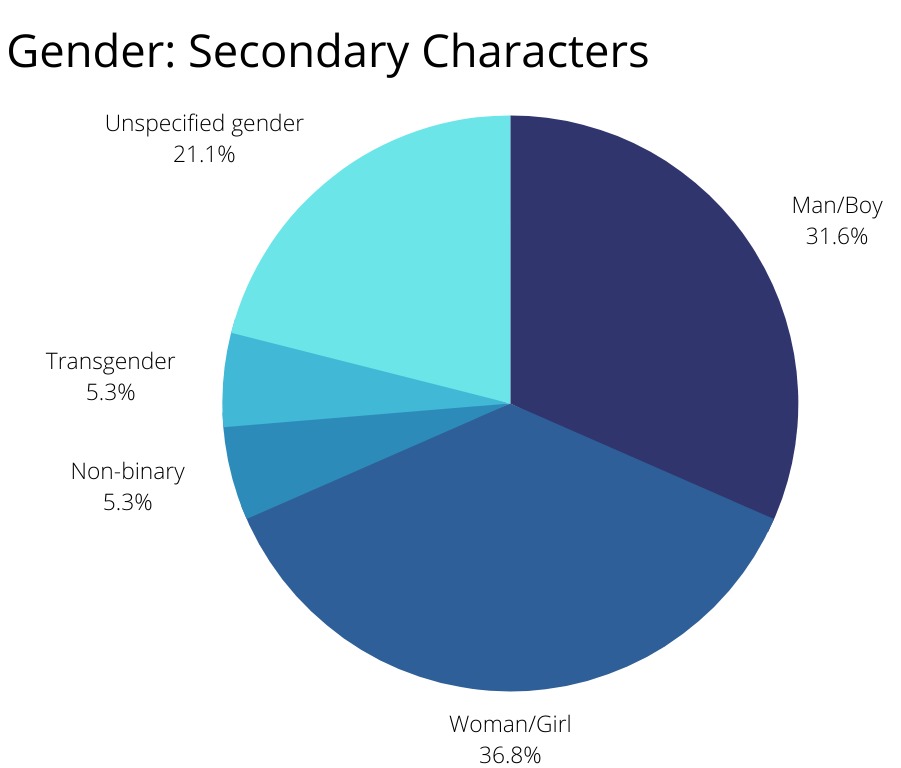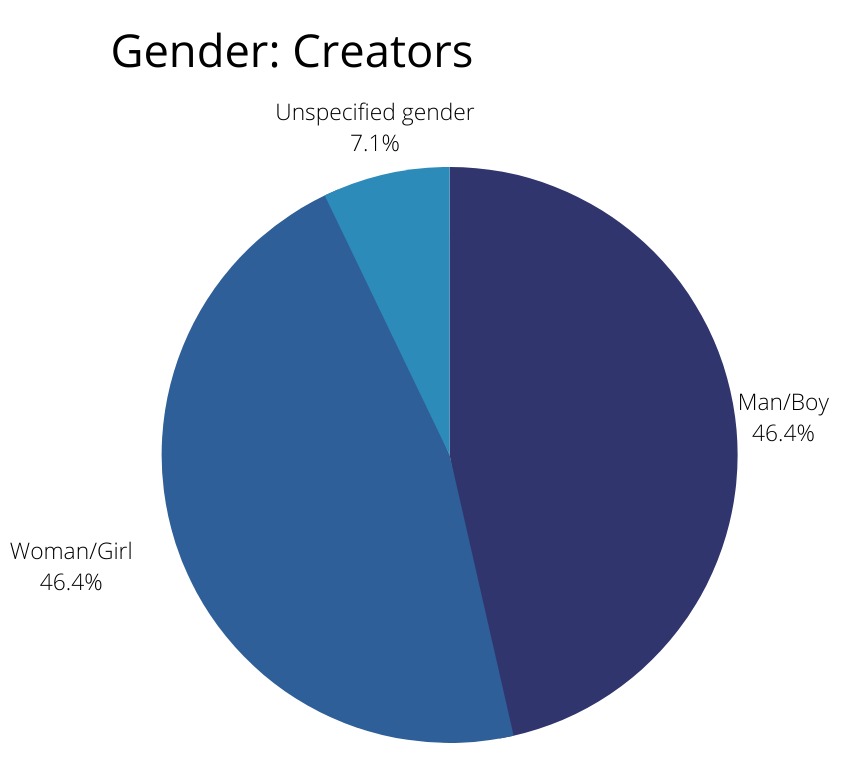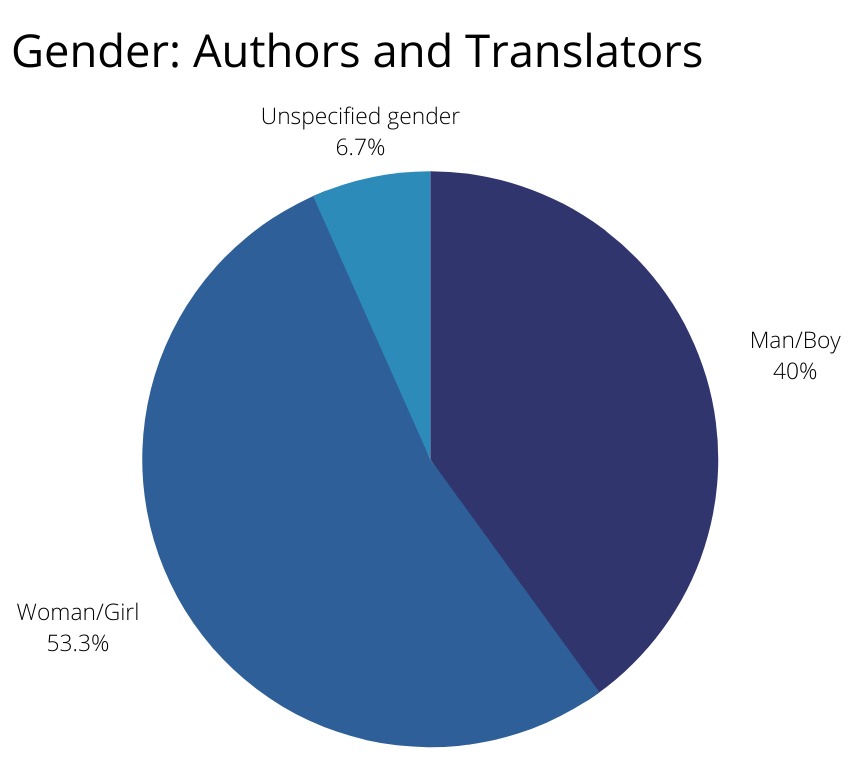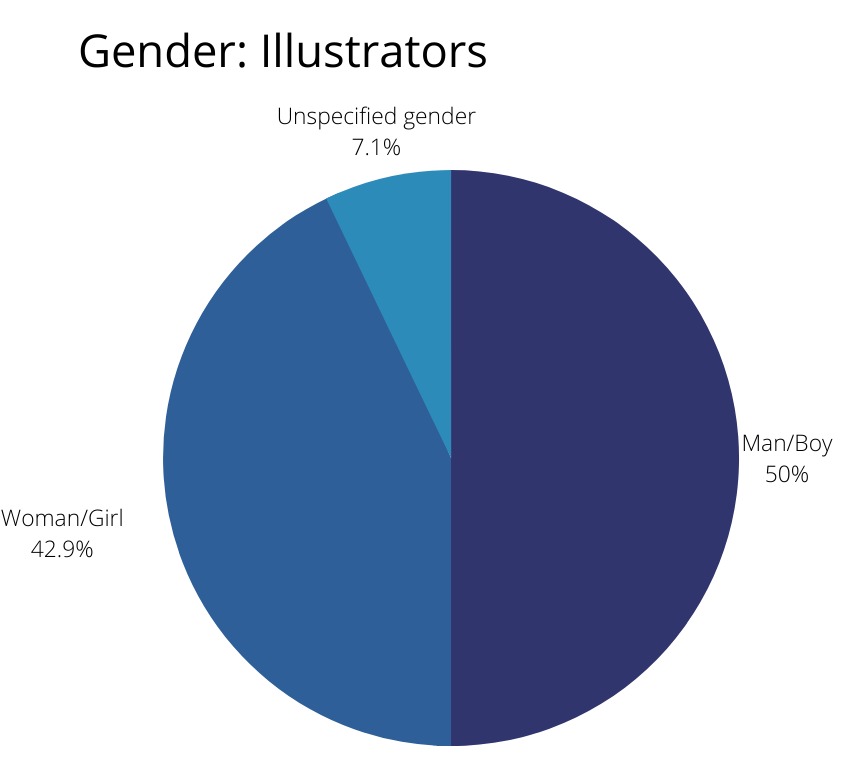What We Found
Representation of Race/Ethnicity
In the thirteen books from the display that we catalogued, we did see some diversity and a concrete effort to include diverse books. In terms of race and ethnicity, for instance, there was a range of ethnicities represented, even though there was a majority of white characters.
The graph below highlights the race and ethnicity representation of the characters, based on our sample analysis at Perfect Books. The dots on each bar represent individual books which have a character or multiple characters of that race or ethnicity.
We decided to include "non-human" characters in this graph because we felt it was important to show that they are sometimes better represented than actual human identities. Given that these non-human characters usually behave in anthropomorphic ways, this creates interesting implications about what the publishing industry considers a human story which young readers can connect to and see themselves in. However, including "non-human" in this graph does not imply that human races are biologically different from each other in the same way that humans are different from animals.
Our findings show that across 13 books, there were 8 instances of white representation, which makes up 27.9% of the total races represented. Additionally, there was 1 instance (3.5%) of multiracial representation, 6 instances (20.9%) of Asian representation, 5 instances (17.4%) of Black/African representation, 3 instances (10.4%) of brown skin representation, 5 instances (17.2%) of non-human representation, and 2 instances (6.9%) of Arab representation. As you can see in our interactive graph, many books had more than one type of representation; in fact, the least-represented groups (Arab, multiracial, and brown skin characters) appeared only in books which also showcased a variety of other ethnicities.
We also looked specifically at the diversity among primary characters and among secondary characters. The range of races represented among primary characters is much smaller. In fact, the majority (44.4%) of protagonists were non-human, even overshadowing the white protagonists, who were close behind with 33.3%. Only two books (Hair Love and Eyes That Kiss in the Corners) had diverse protagonists, showcasing Black (11.1%) and Asian (11.1%) protagonists, respectively.
There was much greater diversity among secondary characters, with more equal distribution: 25% of our characters were white, while 17.9% were Asian, 17.9% were Black/African, 10.7% were brown skin, 17.9% were non-human, 7.1% were Arab, and 3.6% were multiracial. This reflects the fact that the majority of the diversity was in the background, displayed in an ensemble cast rather than at the forefront of the narrative. While this type of diversity is an important type of representation because it shows that racialized characters are a normal part of society, it is also important to centre racialized narratives.
The graph above highlights the race and ethnicity representation of the creators, based on our sample analysis at Perfect Books. Our findings show that 74.1% are white, 11.1% are Asian, 7.4% are Black/African creators, and 7.4% are unspecified.
These percentages demonstrate an overwhelmingly white majority.
As the upper top graph to the left shows, here's what we found among our display's authors and translators:
- 60% are white
- 20% are Asian
- 6.7% are Black/African
- 13.3% are unspecified
As the lower graph to the left shows, here's what we found among our display's illustrators:
- 71.4% are white
- 14.3% are Asian
- 7.1% are Black/African
- 7.1% are unspecified
This white majority reflects the kinds of stories which make up this display; while white creators have incorporated diverse characters in their story, they are less likely to write stories with diverse protagonists, as these stories entail writing outside of their own experience. The white majority among creators shows that in order to increase diverse stories, we need more diverse creators on display.
Representation of Gender
The interactive graph below highlights the gender representation of the characters, based on our sample analysis at Perfect Books. Our findings show that 17.2% of the characters have unspecified genders, 41.4% are men/boys, 34.5% are women/girls, 3.5% are non-binary, and 3.5 % are transgender characters. Characters who are men or boys are in the majority, and, as you can see if you click on the dots, the non-binary and transgender representation is confined to a single book, Bodies Are Cool.
As the upper graph to the left shows, here's what we discovered about the distribution of gender among primary characters:
- 55.6% men/boys
- 33.3% women/girls
- 11.1% of unspecified gender
As the lower graph to the left shows, here's what we discovered about the distribution of gender among secondary characters:
- 31.6% men/boys
- 36.8% women/girls
- 5.3% non-binary
- 5.3% transgender
- 21.1% of unspecified gender
Primary characters were overwhelmingly men/boys, while among secondary characters, women/girls had a slight majority. While women/girls are well-represented, they are usually shown as secondary or background characters, rather than protagonists and heroes leading the narrative.
The graph above highlights the gender representation of the creators based on our sample analysis at Perfect Books. Our findings show:
- 46.4% of the creators are Men/Boys
- 46.4% are Women/Girls
- 7.1% have unspecified genders
There is an even split between men/boys and women/girls; this is a wonderful example of gender equality, particularly in picturebooks, a genre of children's literature which tends to be considered a woman's discipline. However, there is a lack of genderqueer creators, who may or may not be in the unspecified category.
Representation of Religion
Of the thirteen books catalogued, two have religious representation. In both cases, this representation is in the form of Christian primary and secondary characters and faith-specific holiday celebrations in the books Hockey Sweater by Roch Carrier and Merry Christmas, Anne by Kallie George, respectively. The only other notable finding in this category is that three creators, B.J. Novak (author), Sheldon Cohen (illustrator), and Tyler Feder (author/illustrator), identify as Jewish.
Representation of Sexuality
All books in this display feature characters whose sexualities are not specified. Many creators do not specify their sexual orientation on publicly accessible domains. However, this information is available for three authors and one illustrator: Steve Antony identifies as LGBTQAI+, Novak and Suzanne Lang as straight, and illustrator Max Lang as straight also.
Representation of Disability
The single representation of disability appears in Feder's picture book Bodies Are Cool, and it is a representation of physical disability.

